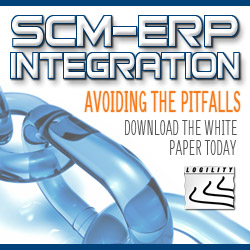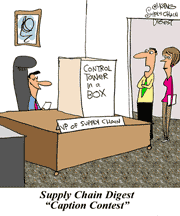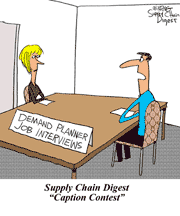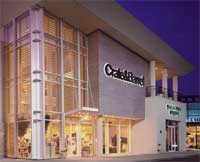 |
October 25, 2013 - Supply Chain Flagship Newsletter |
 |
| THIS WEEK'S SPONSOR: LOGILITY |
 |
Download the White Paper: |
 |
|
|||||||||||||||||||||||||||||||||||||||||||||||||||||||||||||||||||||||||||
Trip Report - CSCMP Conference 2013
|
||||||||||||||||||||||||||||||||||||||||||||||||||||||||||||||||||||||||||||
| GILMORE SAYS: |
"Met many readers and viewers at this year's show - thanks for introducing yourselves. Got quite a few "hey, you're the guy on television" comments. Yep, that's me!" WHAT DO YOU SAY? |
There were 26 tracks this year, down from into the 30+ range in some years past, which is the right direction. As in the last few years, some of the sessions are 90 minutes, the rest an hour, and to me the longer ones start to drag a bit by the end. I would recommend finding a way to schedule it so that all of them are 60 minutes, as it appears the 90 minute ones may be more the matter of schedule convenience than content related (e.g., a 90-minute period takes the schedule from the opening general session to the lunch break).
I had some perceptions of the schedule, and had actually written some comments on it, but I then went back over the full conference program in detail and found that several of my perceptions were wrong. That showed me that as much as I thought I had looked at each offering closely to decide my own schedule, I still missed a couple I might have attended. That is probably true for almost all of us. (I wish conferences had something like an airline flight screen that lists all the upcoming sessions in one easily visible place.)
Again this year, there were a lot of panel discussions among the breakout sessions.
Driving this trend are the barriers many companies have to publicly presenting what they are doing in their supply chains (though thankfully many still do), whereas participating on a panel discussion with little or no slides involved is a much easier thing to get approved.
Here as everywhere, the panel sessions ranged from excellent to somewhat boring, for which the driving factor is almost always the quality of the questions from the moderator. Boring questions beget boring discussions. Every conference, including CSCMP, could use some guidelines and QA work here.
Topics with a lot of coverage in the sessions included network design, multi-channel commerce, risk management (maybe a bit too much), talent management and of course lots on transportation as always. Globalization/China topics were down, which is good because in some recent years there were too many redundant presentations on this subject. As much as I love natural gas powered trucks, eight sessions covering this topic were definitely too many, in my view. But in general the topics were well balanced, and there was more than usual from companies outside consumer goods and retail, which is good.
The conference also always has a number of presentations on the results from various annual studies (the 3PL study, CEO study, the Trends study, etc.). These sessions tend to be very popular, even though frankly the results don't change much year over year. I personally tend to bypass those on the theory I can always read the reports later, whereas company presentations often are not made available after the conference and are unlikely to be repeated somewhere else, where you are unlikely to be even if they were. The CSCMP conference represents the only shot you've got.
Thankfully, the "Supply Chain of the Future" show area was gone after two years, as it really had nothing to do with the future and most prominently featured large material handling equipment displays. It was replaced with the Supply Chain Exchange, a more traditional trade show setting with a decent number of modest booths.
Some quick notes before I get to sessions summaries.
EPA Smartway winners among large shippers went to Best Buy, Home Depot, Lowes, Johnson & Johnson, and Nike. Small and medium size shipper winners were Kimberly-Clark, Toyota Logistics, SC Johnson, Sharp Electronics and Mannington Mills. I would think KCC and Toyota would ship as many pounds per year as Nike, as an aside, but both somehow fell into the mid-sized category.
The supply chain innovation award winner was a combination of Staples and Packsize, for a smarter packaging strategy that led to the usual transportation cost and environmental benefits. PepsiCo was runner up for a zero landfill facility. If there is ever a Vegas line on this, put your money down on the Sustainability entrants - they win almost every year. I was pulling for either e2Open and Motorola's advanced supply chain collaboration and visibility system (for Motorola's supply chain), or IBM's adoption of new advanced supply chain analytics.
The Monday keynote speaker was , Mexico's president from 2006-12, a period of great progress for the country. It was part commercial for the Mexico, although an educational one for sure, but it certainly led me to believe that the country really has made a lot of progress on the issues that were obstacles to its success and clear potential. Calderon is very bullish on the return of manufacturing to North America - but assuming that is true, the question becomes how much will go south of the border versus to the US or Canada. That should be the concern for both of the latter countries.
On Tuesday, keynoter Peter Carlsson, VP of supply chain for electric car maker Tesla, also started out as a bit of a company pitch man - but it worked. I want one. The second half was more supply chain focused, and led me to ponder just how disrupting a company with new supply chain ideas and approaches can be to an industry. Why are tooling lead times in the auto sector still 14-16 weeks after all these years? Tesla aims to get them reduced to just 3-4 weeks - part of its plan to cut new model development times in half versus the norm today. Are there such opportunities in your sector?
The best breakout sessions included the following:
CSX and GE Lighting on Intermodal: CSX provided credible data saying that 14% of the average company's current truckload moves would be well serviced by intermodal. GE's David Slates said that concerns about intermodal service/reliability that may have been true even 5-6 years ago are simply gone today. As one example, he brings containers into LA, moves them on rail to Chicago on BNSF, transfers the containers to CSX which takes them to Atlanta, where they are drayed into a factory in Tennessee. Total transit time is six days, almost without exception, versus five days for truck, but less reliably so. That one extra day sure seems worth the 40% cost savings.
Somewhat unusually, Procter & Gamble's Tom Hughes, shared details of the company's "high-performance work system" (apparently publicly for the first time). It's a highly documented approach honed over 50+ years that now combines P&G's version of about every improvement tool known to man (six sigma, Lean, TQM, etc.). To that they have recently added "vertical start-ups" - an approach that now get almost all new manufacturing line launches up to expected rates in just weeks or even days. Also recently added is "reliability engineering," a relentless approach to reducing variability and some 42 types of production "losses."
Why open the kimono now? Because E&Y saw P&G's results and convinced them to license the IP to others (excluding competitors). More soon.
I think I am going to end it here, and do a part 2 next week. I will close with shout outs to the few companies that really participated in panels and presentations at this year's event. Leaders included Whirlpool, Caterpillar and Home Depot, with four sessions each - thanks and congratulations to them. We even went through the program guide and tallied up all the practitioner contributions (not including 3PLs, who get some marketing out of their efforts), and you will find that interesting data here as our supply chain graphic of the week.
And a special shout out to the relatively small number of practitioners who gave great presentations by themselves, no consultant, technology vendor, or 3PL involved. People like Jason Reiman at Hershey (S&OP journey - heard it was very good), Willis Weirich of Target (on globalization keys), and Tony Nikolai of Whirlpool, with an excellent presentation on getting the politics out of S&OP. There were a few others.
Met many readers and viewers at this year's show - thanks for introducing yourselves. Got quite a few "hey, you're the guy on television" comments. Yep, that's me!
Next year's conference will be in San Antonio. God willing, I'll be there. Hope you will be too. More session summaries next week.
Were you at CSCMP? What did you think or find interesting? Any reaction to Gilmore's summary? Let us know your thoughts at the Feedback section below.
| View Web/Printable Version of this Page |
|
|
|
YOUR FEEDBACK
We received some e-mails regarding how packaging design impacts sustainability. Some samples of this feedback are below.
Feedback - Packaging Megatrends
The "1.5 inch change" graphic is pretty dramatic, but I don't see the focus on "1.5 inch". There were changes to all of the unit load dimensions, but the biggest change was the elimination of a lot of air / dunnage in the outer case pack. They went from 30 cases of 4 each cartons to 75 cases of 4 each by improving the case pack. Package engineering and product engineering should be fully in lock-step and focused on both protecting the product and providing value to the retail and end customer. Apart from functionality and fit, consumers buy products that present well and are not broken.
Steve Murray
|
||
Wagner is 100% on target but like many packaging experts doesn't go deep enough into the freight component which is still the biggest cost bucket: 10X more impact than the box itself. Small package and LTL carriers are very sophisticated in relating packaging to freight efficiency so they weigh and measure many boxes they handle and adjust freight bills as a result...usually raising them. Also there is the aspect of dimensional weight which has become a bigger factor in ground shipments. Many companies still do not understand dimensional weight and how to reduce its impact on shipping cost. LTL carriers derive freight classes from the NMFC book which has about 150 pages of packaging rules that affect freight rates, yet I have dealt with many packaging engineers that do not even know about freight classes or how they relate to packaging. How can they possibly design the optimal distribution package if they do not have that knowledge?
Jack Ampuja |
||
SUPPLY CHAIN TRIVIA ANSWER
Q: How many US factories has Procter & Gamble built in the last 42 years?
A: Amazingly, just 1, a paper products factory in Utah opened in 2011.
| © SupplyChainDigest™ 2003-2013. All Rights Reserved. SupplyChainDigest PO Box 714 Springboro, Ohio 45066 |
POWERED BY: XDIMENSION
|









